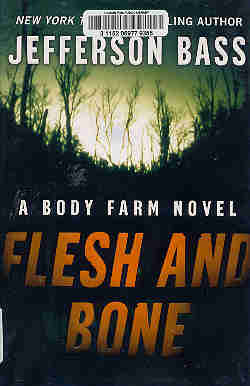Flesh and Bone
Jefferson Bass

I'd be willing to bet that a lot of our faithful readers who own a TV have watched one or more of the various CSI-type programs. You know the the type, where a crime has been committed and the forensic investigators solve it in the small amount of time between commercial breaks. Perhaps you've even wanted to learn more about how forensic scientists really do their jobs, especially since our readers probably realize that trying to learn forensic science from a CSI program is akin to learning about the Apollo space program from Star Trek.
Fortunately for you, this month's review might be just the ticket: Flesh and Bone, a novel written by Jon Jefferson and the famous forensic anthropologist and founder of “The Body Farm” Dr. William Bass. While this book is nominally fiction, it is based on true cases, uses and explains the real science of forensics, and some of the characters are based on real people. With that in mind, you might be envisioning dry text-book like writing. Instead, it is a fast-paced page turner that's impossible to put down.
As an example of how real science is woven in the story consider this exchange between a forester and the main character Dr. Bill Brockton at a crime scene:
“'Sharp eye, wrong interpretation,' I muttered.”
“'How's that?' I had forgotten the forester was with me.”
“'Oh, sorry,' I said, 'I was talking to myself. You see this faint trail of dark fluids?'”
“'Yeah,' he said. 'A drag mark. One of the crime scene guys had pointed it out to me. Said it showed the killing occurred over there at the edge of the woods – said that was the primary death scene, and the tree here was really the secondary death scene.'”
“'I don't think so,' I said, 'You see how the stain is darkest here at the tree, then fades as it leads over there?'”
“He studied the faint trail. 'Maybe, now that you mention it. So what?'”
“'What I think we're looking at here is a maggot trail.'”
“'A maggot trail?'”
“'Sometimes, when the maggots are ready to cocoon and turn into flies, they crawl away from the body to find a more protected place. Probably so they won't get gobbled up by birds. And for reasons we don't understand, when they do that, they all tend to head in the same damn direction, like a herd of sheep of cows, or a bunch of lemmings.'”
In that one short scene, we've learned a little bit on how to read a death scene, and also some of the limitations on our current knowledge – and it all fits into the story. Or consider the following scene immediately prior to a hearing:
“To one side, a stenographer perched at a much smaller table, her fingers poised over the odd little machine she used to transcribe words. Her machine, a stenograph, looked more like an old-fashioned adding machine than a computer or typewriter; as she typed, though, she would often press two or three keys at once like playing a chord on a piano. I had once asked a court reporter to explain and demonstrate the technique to me. 'I'm transcribing sounds, not words....' sometimes a 'chord' represented a syllable; sometimes an entire word; in one case, even and entire phrase.”
Now we've all seen courtroom scenes on TV, but when have you ever had a stenograph explained before? Be sure to read all about it!
All Rights Reserved.